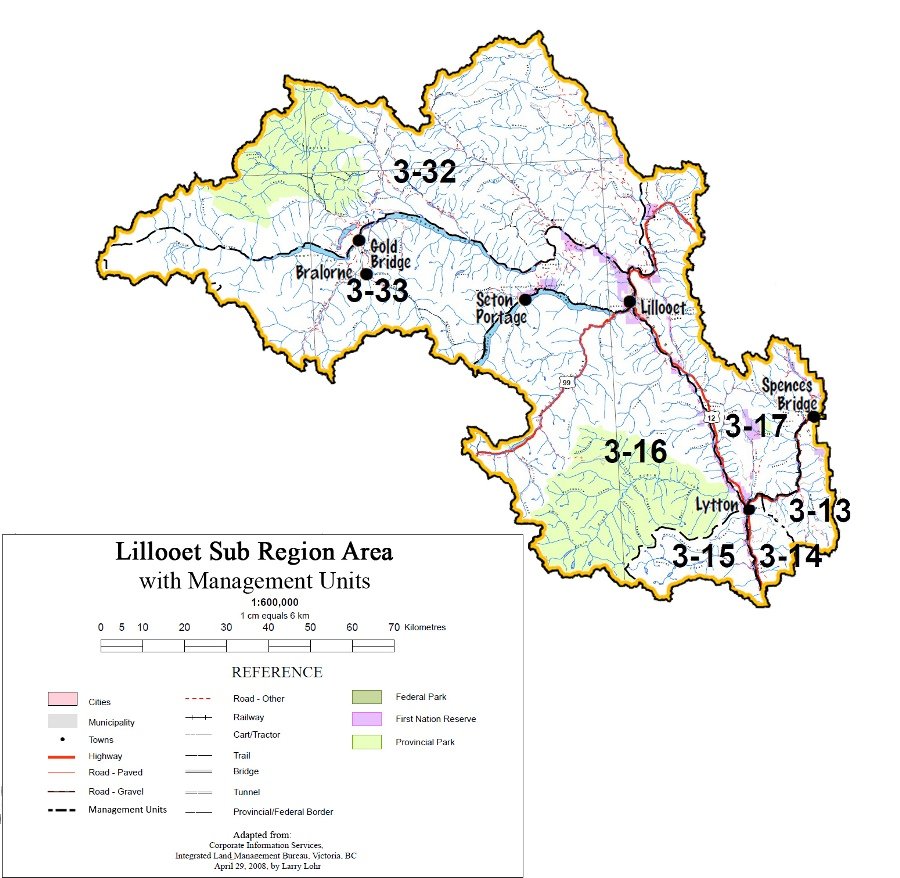Main Sections
Biodiversity in Dry Forest and Grasslands
Grasslands (NDT4a) and dry open forests (NDT4b) have a high percentage of rare, threatened, sensitive or vulnerable wildlife, plants and plant communities. Frequent, low-intensity fires have played an important role in maintaining some dry forests and grasslands (see map). Continuing the role of fire within these dry ecosystems is important to maintaining their biodiversity.
Issues:
- Conversion of grasslands (NDT4a) to forests reduces their productivity and diversity, and habitat for wildlife and species at risk.
- Open dry forests (NDT4b), dominated by old growth, have changed to dense forest stands. This results in greater impacts to species at risk and biodiversity, poorer forage and timber production, and greater risk of catastrophic wildfire.
- Unregulated access can disturb and degrade grasslands and dry forests and increase risks to wildlife (including species at risk).
- Key problem areas are not identified or appropriately managed.
- Inadequate knowledge of fire-maintained ecosystems.
- Healthy, functioning fire-maintained ecosystems
Forest Biodiversity and Grassland Ecosystems
| Objectives | Management Direction/Strategies | Measures of Success/Targets | Intent |
|---|---|---|---|
| 1. Manage grazing, harvesting, silviculture techniques and burning activities to maintain or enhance the natural structure, function, health and productivity of dry forests and grasslands (see map) | 1.1 Use silviculture and burning activities to reduce conifer encroachment and improve grassland productivity in NDT4a grasslands | Healthy grasslands distributed across historical ranges Grazing and fires support natural distributions of grasslands and dry forests Dry forests with natural stand structure conditions Improved wildlife habitat, enhanced forage productivity for livestock and wildlife use, improved forest health and productivity, and increased biodiversity and connectivity | |
| 1.2 Manage grazing prior to burning to allow the build up of fine fuel. Allow for adequate re-growth of grasses and forbs after burning | |||
| 1.3 Define realistic and attainable desired plant communities to reflect the desired seral stage distribution | |||
| 1.4 Develop and implement management prescriptions in range use plans to ensure that rare plants, rare plant communities and habitats for wildlife species at risk persist across their natural range | |||
| 1.5 Manage silviculture and fire activities to reduce ingrowth and enhance the understorey layers in open forested ecosystems (NDT4b) | Classical NDT4 attributes are: large-diameter, widely-spaced trees, a well developed grass/shrub understorey, and mosaics of thickets and openings Silviculture activities may include, , for example, maximum and minimum stocking standards, regeneration delay, stand density and species selection | ||
| 1.6 Encourage a variety of silviculture treatments (with a preference for mechanical treatment where this is beneficial to wildlife & livestock) where it is impractical to burn, or prior to burning in forested sites | |||
| 1.7 Use cluster planting to meet stocking standards and allow plant succession to progress naturally in non-planted openings (voids) | |||
| 1.8 In open forests, manage stand structures by site series to best imitate classical NDT4 stand structures | Develop and implement site series specific prescriptions to achieve desired stand structure (incorporating recommendations of the Kamloops Forest Region NDT4 Committee). Operational forestry plans should provide a range of opening (cutblock) sizes. Leave coarse woody debris where it would normally occur (i.e., in wet sites and very dry fireproof sites). Leave coarse woody debris where previous harvests have removed snag components. Within NDT4b sites, maintain 10 to15 tall, large diameter snags per 10 hectare area where they exist and create where they do not. Ensure there is more emphasis on snag retention in dry site series (02, 03, and 04). Utilize logging to open up stands | ||
| 1.9 Explore and encourage First Nation research initiatives to reintroduce burning practices back into traditional use areas | |||
| 1.10 Consider available First Nations’ knowledge of traditional use and prescribed burning when developing burn plans | |||
| 1.11 Implement management prescriptions that include management for fire dependent species and ethno-botanical purposes | |||
| 1.12 Consult with First Nations during the development and implementation of district burn plans within their traditional use areas | |||
| 2. Manage mechanized and motorized access in grassland areas (NDT4a) and dry forests (NDT4b) to minimize disturbance and degradation. (Also see the Access section) | 2.1 Discourage indiscriminate, offroad and off-trail, mechanized or motorized use | ||
| 2.2 Control access in vulnerable areas (e.g., wet or seasonally wet sites; aspen copses and shrub complexes; cliff habitats and rocky slopes, areas of high biodiversity, known areas of species at risk) | |||
| 2.3 Monitor access strategies and activities in terms of their impacts on species at risk | |||
| 2.4 Evaluate existing access in terms of the habitat needs of species at risk and implement measures to minimize threats to those habitats | |||
| 2.5 Encourage education of public recreational users to minimize disturbance and degradation of NDT4 | |||
| 3. Continue provincial research and inventory work to increase knowledge of NDT4 ecosystems | 3.1 Conduct inventories to the Biogeoclimatic Ecosystem Classification site series level to delineate NDT4 ecosystems and to determine opportunities for rehabilitation | ||
| 3.2 Seek funding to maintain or expand the network of range reference areas in NDT4 to support the study of natural processes | |||
| 3.3 Utilize First Nations’ knowledge of and traditional management regimes for NDT4 ecosystems | |||
| 3.4 Delineate and map grasslands using various tools (e.g., historical air photos), to include areas that were once grasslands and are currently mapped as forest |
